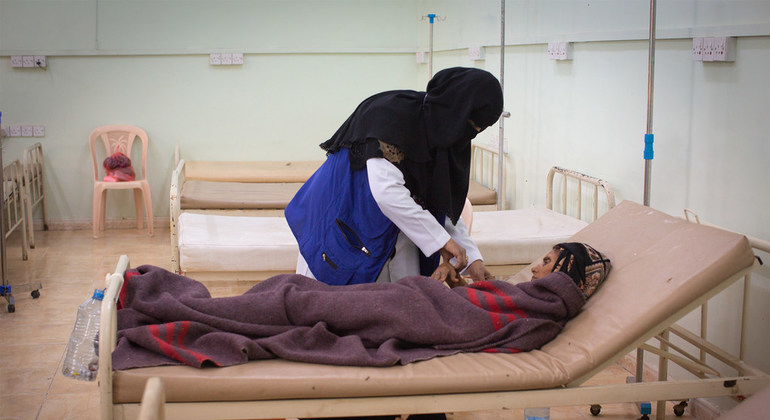Condemning the attack on Kitaf District in northern Sa’ada Governorate – and intensified fighting in Taizz city in the south-west of the country that shut another hospital at the weekend, Lise Grande, Humanitarian Coordinator for Yemen, said that it was “unconscionable” that facilities were being destroyed “just when people need them the most”.
She added: “Cholera is starting to spread like wildfire across the country. In the past three months, we’ve seen 200 deaths and more than 110,000 suspected cases.”
The Office of the High Commissioner for Human Rights (OHCHR), meanwhile, said on Wednesday that colleagues in Yemen were preparing to investigate the Sa’ada airstrike to verify the number of civilian casualties.
Up to 14 March this year, OHCHR has verified the deaths of 7,072 civilians, since March 2015, and 11,205 have been injured. The real toll is likely far higher.
According to the UN Office for the Coordination of Humanitarian Affairs (OCHA), at least two people were killed and five injured during clashes in Taizz’s Al Mudhaffer district.
“International humanitarian law is unequivocal on this point,” Ms. Grande insisted. “Parties which resort to arms are required to do everything possible to protect hospitals and health facilities. This is not a voluntary commitment—it is a fundamental responsibility.”
Health teams ‘working day and night’ to stop cholera resurgence
Although the current cholera and diarrhoea outbreak is smaller than two years ago, when more than one million cases were reported, there are serious concerns that the coming rains and lack of basic healthcare facilities could spark a huge rise in infection levels.
Nearly one third of the reported cases are children under-five, the World Health Organization (WHO) warned.
“Our teams in Yemen are working day and night with a wide network of local partners to respond and stop the further spread and transmission of the diseases,” WHO said in a joint statement with UN Children’s Fund (UNICEF). “We fear that the number of suspected cholera cases will continue to increase with the early arrival of the rainy season and as basic services, including lifesaving water systems and networks, have collapsed.”
Numerous problems have exacerbated the risk of a massive outbreak, including poor sewage disposal systems, the use of contaminated water for agriculture, unreliable electricity to store food and escalating violence in Hudaydah and Taizz, forcing families to flee their homes.
More than four years since fighting escalated in Yemen between supporters of Yemeni President Abd Rabbu Mansour Hadi and Houthi opposition groups, Yemen is the world’s worst humanitarian crisis, the UN says.
In a recent appeal for help from international donors to save millions from starvation, UN Secretary-General António Guterres warned of an “overwhelming humanitarian calamity”.
Some 360,000 children suffer from severe acute malnutrition, Mr. Guterres told Member States last month, before citing one credible report that more than 80,000 children under five had died of starvation.
According to OCHA, nearly 80 per cent of the total population – 24.1 million people – require some form of humanitarian assistance and protection. Ten million people are a step away from famine and starvation and seven million are malnourished, it said in a statement.
To date, the $4.2 billion 2019 Yemen Humanitarian Response Plan (YHRP) is only five per cent funded.



